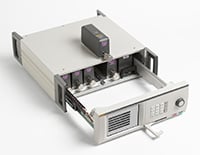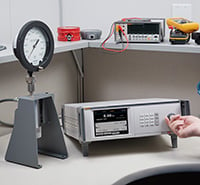- Other Fluke companies:
- Fluke
- Fluke Biomedical
- Fluke Networks
- Fluke Process Instruments
Equipment Tips for Pressure Controllers in the Production Process
Customers often request the most accurate piece of equipment available, but the most accurate product is not always the best solution for their needs. If you are planning to purchase a new pressure controller for production, there are several areas that you should consider before determining which piece of equipment is right for your use case.
When purchasing a pressure controller, it’s important to consider your accuracy and pressure needs, the product’s environment, expected uptime, budgetary restraints, and long-term plans for your business.
Pressure Range and Accuracy
First, you’ll need to know what you want to accomplish as far as pressure range and accuracy. Typically, more accuracy is also more expensive. Focus on finding a solution that will not only meet your pressure needs but also your budgetary needs.

Modular systems, like the 8270A and 8370A High-Pressure Controllers / Calibrators, allow more flexibility, because there are a wide variety of modules with different pressure ranges. This provides the flexibility to handle a variety of applications and workloads. Uncertainties as good as 0.01 % reading are available across the majority of the range. You can also expand your ranges or improve accuracy in the future by simply purchasing another pressure module.
The 8270A and 8370A are most likely to be used in calibration labs, but the controllers can also to be used successfully in automated applications, like manufacturing test environments and validation. In these cases, the customer may be running the same type of test repeatedly. Throughput, consistency, and repeatability become very important in these cases.
In manufacturing situations, the ability to rack mount the instrument and control it from a computer or data acquisition source may be very important. These situations require an instrument that can be integrated into an existing system, where many instruments may be running at the same time. This just isn’t possible with something like a deadweight tester, which is inherently a manual instrument.
Environment
Once pressure and accuracy needs have been decided, the second thing you should examine is the environment that the product is going into. In a production environment, we question whether the device is only used for new production or for customer RMAs and returns as well?

A common failure in returned pressure devices is damage or contamination of the pressure device itself. The 8270A, 8370A, and 6270A pressure controllers have an accessory known as a Contamination Prevention System (CPS). With the optional CPS, these controllers can calibrate both gas-filled and liquid-filled devices without concern of contamination. This is something that would be important to consider if you have a risk of getting contaminated devices in from the field.
This CPS system consists of an exterior coalescing filter with a solenoid-controlled purge valve that is under the control of the calibrator. When the calibrator is venting from the device, it vents through the CPS as opposed to venting the pressure and possibly contaminants out of the device and back into the calibrator.
The CPS was an accessory that was developed for the 6270A Pressure Controller / Calibrator because of customers’ requests to solve this kind of problem. We’ve carried it forward into the 8270A and 8370A Modular High-Pressure Controllers, with ability to carry up to the 15000 PSI capability.
The third thing that we look at for the production process is what is needed in terms of spares and related systems regarding uptime. The modular nature of the controller means that the pressure measurement modules and much of the pressure control pneumatics are contained in user removable pressure modules. The system is easier to maintain both in terms of recalibration and unexpected repairs.
Uptime, Downtime, and Spare Modules

For systems that need nearly 100% uptime, spares are indicated for all user-removeable components. If, for instance, a pressure control module fails, the user can simply depressurize the system, swap the control module while the controller is still in the rack, and resume operations – perhaps within minutes, assuming they have sufficient spares on hand.
It’s not always necessarily indicated. These products are very reliable, and, in some cases, people may not necessarily require 100% up time.
Summary
When considering a pressure controller for the production process, it’s important to remember that the most accurate product is not always the best product for your needs. Consider your pressure range and accuracy needs, the environment the product is going into, and the expected uptime.
The products most often recommended for the production environment is the 8270A and 8370A Modular High-Pressure Controllers, because the modular nature of these products allows a lot of flexibility in terms of budget and potential growth. The 8270A and 8370A also have the capability to be rack mounted and automated, which is a common need in manufacturing and production environments.
Keep learning
Three Reasons to Consider a Modular Pressure Control System
Commonly Asked Questions about the 8270A and 8370A High-Pressure Controllers
Technology and Automation in Modular High-Pressure Controllers
Related products
8270A and 8370A Modular High-Pressure Controllers / Calibrators
Get Help
Speak with a calibration product expert about your equipment needs
- Home
- Products
- New Products
- Electrical Calibration
- RF Calibration
- Data Acquisition and Test Equipment
- Temperature Calibration
- Humidity Calibration
- Pressure Calibration
- Flow Calibration
- Process Calibration Tools
- Calibration Software
- Service and Support
- All Calibration Instruments
- Purchase Info
- News
- Training and Events
- Literature and Education
- Service and Support
- About Us



